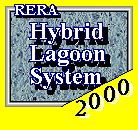
COPYRIGHTS
1999-2009 RERA
All right reserved.
Any Unauthorized
Copying
or Using Prohibited.
Preface
Table
of Contents
Foundation
Hybrid
Lagoon System
Case
Study
Applications
Proposals
16. Development of Hybrid Lagoon Technology and Comparison of Systems.
Research initiated to answer the question of whether activated sludge (microorganisms) could be used to remove nitrogen, began with a search for unique microorganism functions related to nitration and denigration action. With the development of the water flow model, instrumentation system and aeration method required for microorganism denitrification functions, ultimately a hybrid lagoon and automatic control system emerged which combined an extremely simple hybrid lagoon basin construction with automatic control through analysis of measured waveforms. Hybrid lagoon automatic control systems (employing the LLSB activated sludge treatment method) as a rule perform secondary and tertiary processing using only a single basin (high-level waste water treatment), while denitrification by microorganism reactions is accomplished solely through accurate control of the aeration volume during secondary processing. No methanol or other sources of carbon are added to circulating sludge. Hence in biological denitrification (tertiary) processing, the facility and energy costs, and the energy required for secondary processing is not necessary.
|
Item |
The way of a serial 3-step treatment |
Hybrid lagoon system |
|
The method of the treatment |
continue |
non-continue |
|
The structure of the establishment |
complicatedly |
simply |
|
A necessary area |
usually |
equally |
|
Construction cost |
high |
cheap |
|
Medicine use quantity |
A large quantity |
It isn't used. |
|
The power quantity that a denitrification treatment takes it |
abundant |
little |
|
Automatic control |
Impossibility |
It is possible. |